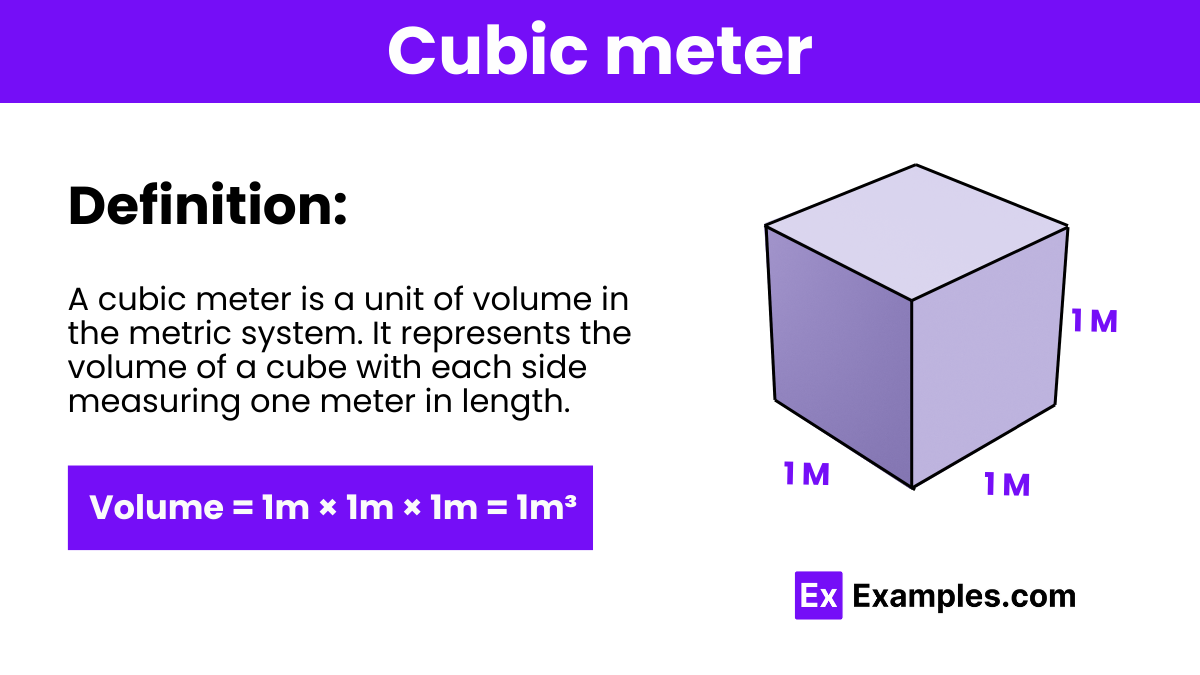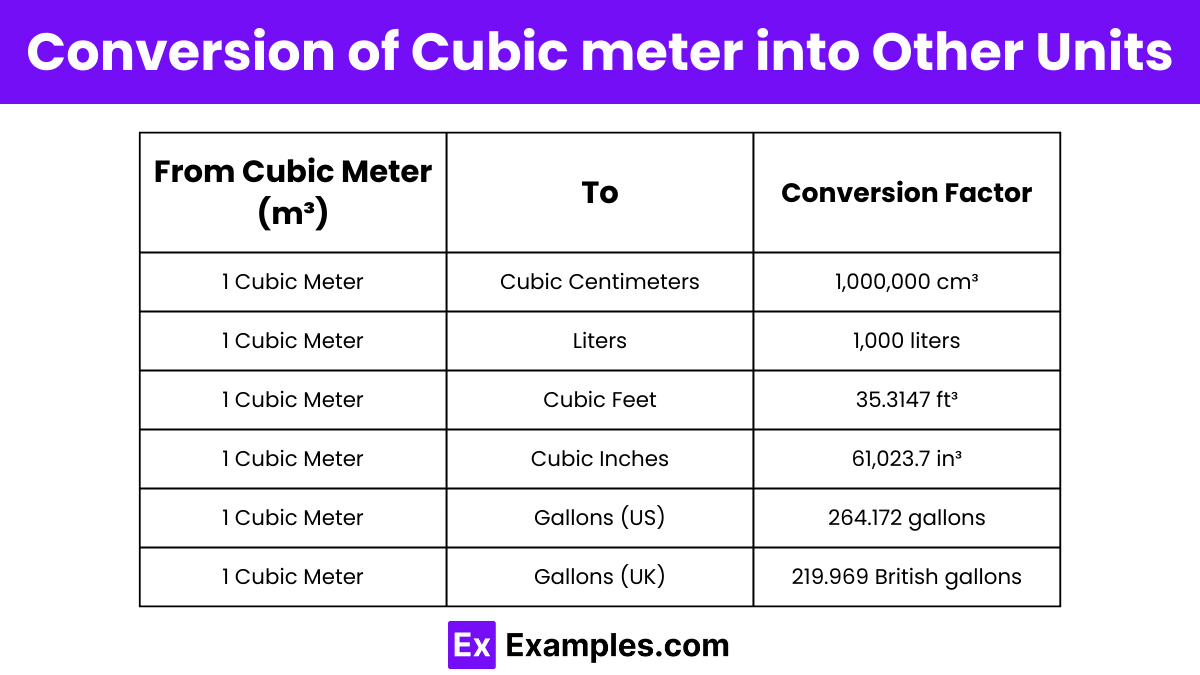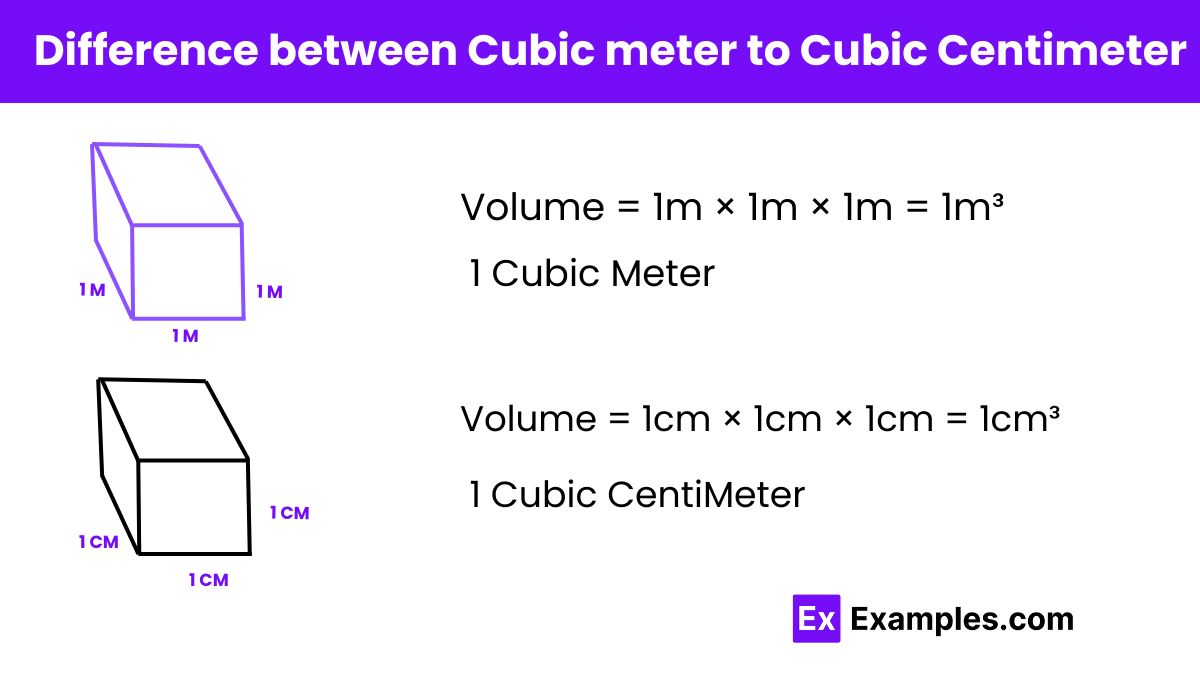What is the volume of a cube with each side measuring 1 meter?
1 cubic meter
2 cubic meter
3 cubic meter
4 cubic meter


A cubic meter is a unit of volume in the metric system. It represents the volume of a cube that measures one meter on each side. It is commonly abbreviated as “m³“. One cubic meter is equivalent to 1,000 liters or 1,000,000 cubic centimeters. It’s used to measure the volume of large objects or quantities of substances like liquids, gases, or solids.
The unit of measurement for volume represented by cubic meter is abbreviated as “m³” and is read as “cubic meters.
Cube: A cube is a six-faced geometric shape where all sides are equal in length. The volume of a cube is calculated, where “s” is the length of the side. using the formula
Rectangular Prism: A rectangular prism is a six-faced shape with all rectangular faces. Its volume is calculated , where “l” is the length, “w” is the width, and “h” is the height. using the formula
Cylinder: A cylinder has two circular faces and a curved surface. The volume of a cylinder is calculated, where “r” is the radius of the circular base and “h” is the height. using the formula
Sphere: A sphere is a perfectly round geometrical object in three-dimensional space. The volume of a sphere is calculated, where “r” is the radius. using the formula
Cone: A cone has a circular base connected to a single vertex. Its volume is calculated, where “r” is the radius of the circular base and “h” is the height. using the formula
Pyramid: A pyramid has a polygonal base and triangular faces that meet at a common point called the apex. The volume of a pyramid is calculated , where “B” is the area of the base and “h” is the height. using the formula
| Shape | Formula for Volume (V) |
|---|---|
| Cube | V = s³ |
| Rectangular Prism | V = l × w × h |
| Cylinder | V = πr²h |
| Sphere | V = 4/3 πr³ |
| Cone | V = 1/3 πr²h |
| Pyramid | V = 1/3 B h |

| From Cubic Meter (m³) | To | Conversion Factor |
|---|---|---|
| 1 Cubic Meter | Cubic Centimeters | 1,000,000 cm³ |
| 1 Cubic Meter | Liters | 1,000 liters |
| 1 Cubic Meter | Cubic Feet | 35.3147 ft³ |
| 1 Cubic Meter | Cubic Inches | 61,023.7 in³ |
| 1 Cubic Meter | Gallons (US) | 264.172 gallons |
| 1 Cubic Meter | Gallons (UK) | 219.969 British gallons |
This conversion is useful for smaller volumes in scientific or technical contexts where precision is necessary. A cubic centimeter is a cube whose sides are all 1 centimeter long.
Since a liter is defined as the volume of a cube that is 10 centimeters on a side, converting cubic meters to liters is straightforward. This conversion is common in everyday uses like measuring water.
Used predominantly in the United States and the UK for non-metric volume measurements in construction and appliance capacities. A cubic foot is a cube with each side measuring one foot.
Important for industries that use the imperial system, like manufacturing and automotive sectors. A cubic inch is a cube that is one inch on each side.
Cubic Meters to Gallons (US)
Commonly used in the United States for measuring larger volumes of liquids, like water and gasoline. The US gallon is used over the imperial gallon in American commerce.
Used in the UK, this conversion helps measure volumes in scenarios where the British imperial system is still in use, like in fuel economy and some agricultural settings.

| Measurement | Description | Conversion Factor |
|---|---|---|
| Cubic Meter (m³) | Volume unit in the metric system representing a cube with each side measuring one meter. | 1,000,000 cm³ |
| Cubic Centimeter (cm³) | Volume of a cube with each side measuring one centimeter. | 0.000001 m³ |
To calculate cubic meters, you typically multiply the length, width, and height of an object or space together. For irregularly shaped objects, you may need to use specific formulas for their respective shapes.
Common objects measured in cubic meters include swimming pools, rooms, shipping containers, fish tanks, water tanks, and grain silos, among others.
Cubic meters measure volume, representing the amount of space an object or substance occupies in three dimensions (length, width, and height), while square meters measure area, representing the size of a two-dimensional surface.
You can convert cubic meters to other units such as liters, cubic centimeters, or cubic feet using conversion factors. For example, 1 cubic meter is equal to 1000 liters, 1,000,000 cubic centimeters, or approximately 35.31 cubic feet.
For irregularly shaped objects, you can use methods such as water displacement or mathematical integration to estimate the volume. Alternatively, you can approximate the object’s volume by dividing it into smaller regular shapes and summing their volumes.
Text prompt
Add Tone
10 Examples of Public speaking
20 Examples of Gas lighting
What is the volume of a cube with each side measuring 1 meter?
1 cubic meter
2 cubic meter
3 cubic meter
4 cubic meter
How many liters are there in 1 cubic meter?
10 liters
100 liters
500 liters
1000 liters
Which of the following represents a volume?
Meter
Square meter
Cubic meter
Kilometer
What is the volume in cubic meters of a box measuring 2m x 3m x 4m?
12 cubic meters
20 cubic meters
24 cubic meters
30 cubic meters
How many cubic centimeters are there in 1 cubic meter?
100 cm³
1000 cm³
10,000 cm³
1,000,000 cm³
What is the volume in cubic meters of a cylinder with a radius of 1 meter and a height of 2 meters?
2π cubic meters
π cubic meters
4π cubic meters
6π cubic meters
How many cubic meters are in a rectangular tank that measures 2m x 1m x 0.5m?
0.5 cubic meters
1 cubic meter
2 cubic meters
3 cubic met
Convert 3 cubic meters to liters.
300 liters
3000 liters
30 liters
30000 liters
Which unit is larger?
1 cubic meter
1 cubic centimeter
1 cubic millimeter
1 liter
If a swimming pool has a volume of 500 cubic meters, how many liters of water can it hold?
500 liters
5000 liters
50000 liters
500000 liters
Before you leave, take our quick quiz to enhance your learning!

